Please Take Note: This is a review of the game’s final prototype. The art, game bits, and the rules discussed are all subject to change. The game is being reviewed on the components and the rules provided with the understanding that “what you see is not what you might get” when the game is published. If you like what you read and want to learn more, we encourage you to visit the Kickstarter project page. Now that we have all that disclaimer junk out of the way, on with the review!
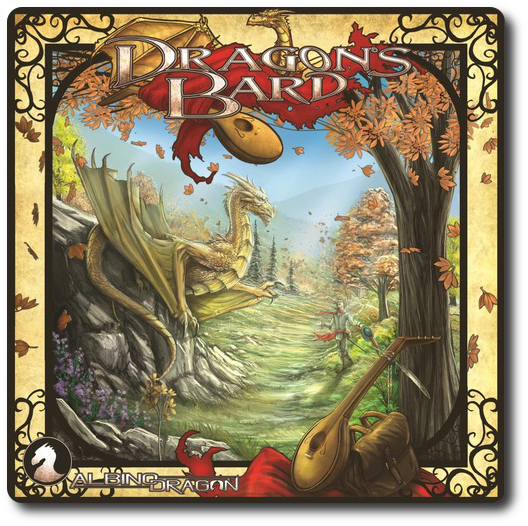
The Basics:
- For ages 5 and up (publisher suggests 10+)
- For 3 to 4 players
- Approximately 30 minutes to complete
Geek Skills:
- Active Listening & Communication
- Counting & Math
- Logical & Critical Decision Making
- Pattern/Color Matching
- Strategy & Tactics
- Hand/Resource Management
Learning Curve:
- Child – Easy
- Adult – Easy
Theme & Narrative:
- Travel across the realms to collect stories and become the greatest bard who ever lived to save a Kingdom!
Endorsements:
- Gamer Geek approved!
- Parent Geek approved!
- Child Geek approved!
Overview
The only things standing between a dragon’s wrath and the people of the Kingdom is a bard. But not just any bard, the Dragon’s Bard. This individual wanders the lands in search of great stories about great people doing great deeds. He collects them, memorizes them, and then makes the journey to the dragon’s lair. There, he tells the tales he has learned to the great and powerful Khrag, a dragon of legend who is to be feared. If Khrag is pleased by the tales, the Kingdom is saved for a time. If the dragon is not entertained, the lands will burn.
Dragon’s Bard, by Albino Dragon and based off of Tracy and Laura Hickman’s “Dragon’s Bard” book series, is comprised of 1 game board, 1 Dragon miniature, 38 Bard cards (in 5 different colors with number values 1 through 7, including 3 Dragon Rage card types), 5 Bard tokens, 35 Story tokens (in 5 different colors with number values 1, 2, 3, and 5), 40 Mandolin tokens, 40 Rumor tokens, and 1 First Player token. As this is a prototype of the game, we will note comment on the game component quality. HOWEVER, what we received was simply beautiful. The attention to detail, the outstanding illustrations, and quality of the prototype pieces left us exceedingly excited to see what the final game will look like!
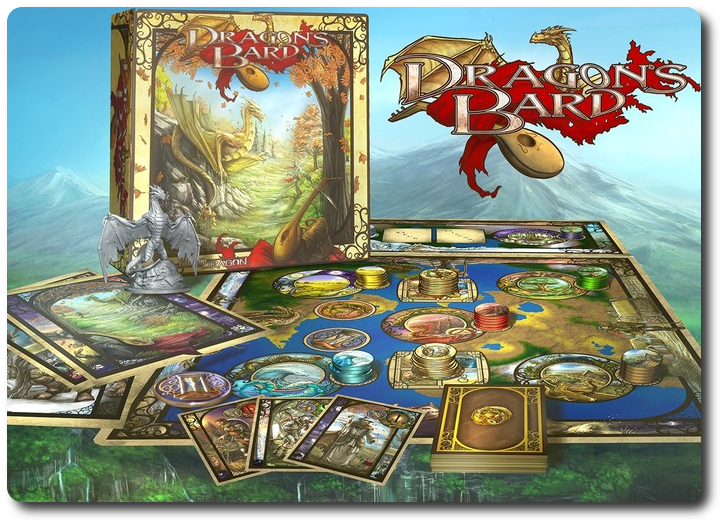
Example of the proposed final product – My Head Explode
Tuning the Mandolin
To set up the game, place the game board in the middle of the playing area. Players can sit wherever they like but should be within easy reach of the game board at all times.
Place all the Mandolin tokens and Rumor tokens in their reserved spot on the game board. At this time, also place the Dragon miniature on the board in any of the five regions. The First Player token should also be placed on the board at this time until claimed by a player during the game and the 5 Bard tokens placed to one side of the board.
Now separate the five colors of Story tokens that have an image of one of the five regions on one side and a number value on the other. Make sure the number value is face-down and then randomize the groups. Select 5 Story tokens from each group, making sure you keep the number value face-down so no player can see them, and then stack the tokens into a single column. Place each stack of Story tokens on their matching region on the game board. The remaining Story tokens are discarded for the duration of the game, but keep the number values hidden.
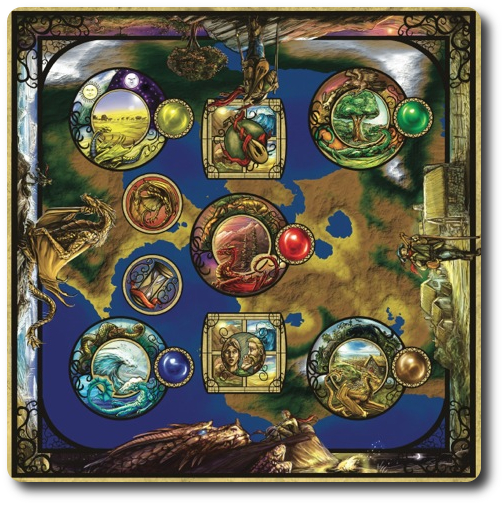
Example of what the final board might look like for the game
Now shuffle the Bard deck and deal out to each player 8 cards if playing a 4-player game or 10 cards if playing a 3-player game. Players are welcome to pick up their cards and organize them by color and value, but should not reveal their cards to their opponents.
Place the deck to the side of the game board and draw the top card, placing it next to the deck, face-up. This indicates the initial trump color. The Bard token that matches the color of the Bard card drawn is placed on its reserved spot on the game board as a reminder to all the players what the current trump color is. In the event that a Dragon Rage card type is revealed, no Bard token is placed indicating there is no trump for the current round.
You are now ready to play!
A Bard’s Wanderlust
The game will be played in rounds with each rounding having a First Player. The First Player title will change many times during the game, but the individual who holds the title will always complete the following steps:
- Place the Dragon miniature in one of the five regions with Story tokens (if this is the first round, this step is skipped).
- Play one Bard card from their hand (this is referred to as the lead card).
Now it is the other player’s turn. Starting with the next player going clockwise, each player now places a Bard card from their hand, too. The intent is to win the hand (or “trick”) and win a Story token from the region the Dragon is currently occupying. This is done by playing a Bard card that matches the same color as the lead card with the highest number value or playing a Bard card that matches the current Bard token color. If this is done, the card acts as a trump and will always beat any other card except another trump card with a higher number value.
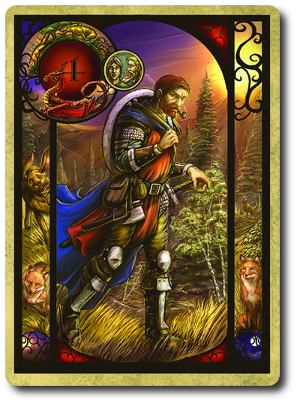
Bard card example – note the small icon in the upper left next to the color – this identifies the card’s perk
Players must play Bard cards that match the color of the lead card if they have them. If they do not, the players must play a trump card. If they have neither, any of the three remaining card colors can be played.
The winner of the hand (or “trick”) collects all the cards played and places them in a stack face-up in front of them. They then collect the top Story token from the region where the Dragon miniature is currently located, making sure to not reveal its number value to any of the other players. Optionally, the players can chose to have all claimed Story token values face up. If the player won the trick using a card that matched the lead card, they also collect 1 Mandolin token.
The player who won the trick is, by default, the First Player for the next round. Play continues as described above until the end of the game.
Once all the cards are played, all the cards are collected by the First Player, shuffled, and a new hand is dealt to the players, as well as a new trump color.
A Bard Full of Tricks
While winning tricks is the goal of each round so as to collect Story tokens, the cards played not only determine if the trick is won but also provide special perks. They are as follows:
Bard Card with a Value of “1”
The first player to play a Bard card with the value of “1” becomes the First Player for the next round regardless of who wins the current trick. The First Player token is given to this player immediately. Any additional Bard cards with the value of “1” played do not provide any special perk for the duration of the hand.
Bard Card with a Value of “2”
Whenever any player plays a Bard card with the value of “2”, they immediately collect 1 Mandolin token. Any additional Bard cards with the value of “2” played do not provide any special perk for the duration of the hand.
Bard Card with a Value of “3”
Whenever any player plays a Bard card with the value of “3”, they can draw and replace the current shown Bard card that has determine’s the hand’s trump color. This new card might change the current trump color for everyone. As such, this is an optional perk. Any additional Bard cards with the value of “3” played may also choose to replace the current Bard card that has determined the current trump color.
Bard Card with a Value of “4”
Whenever any player plays a Bard card with a value of “4”, they immediately collects 1 Rumor token. Any additional Bard cards with the value of “4” played do not provide any special perk for the duration of the hand.
Bard Card with Dragon Rage
A Dragon Rage can be played even if the player has a playable card or trump for the current hand. Once played, no player can win the trick regardless of the card’s already played or played later in the hand. However, all cards played after the Dragon Rage can be any Bard card of any value or color. Additionally, the player who played the Dragon Rage automatically takes the First Player token, even if another player played a Bard Card with a value of “1” before or after the Dragon Rage, but any Dragon Rages played after the first can steal the First Player token.
The Song’s End
The game ends when all the Story tokens have been claimed from the regions on the board. The dragon is most pleased and it is now time to determine who the greatest bard in the Kingdom is. The player’s score is determined by adding the following:
- All claimed Story token number values
- +1 for every Mandolin token
- Additionally, the player with the most Rumor tokens receives +5 bonus points
The player with the most points wins and has pleased the dragon with the their tales of adventure and romance!
To learn more about Dragon’s Bard, see the Kickstarter project page.
Prediction
My little geeks have played plenty of card games, including the classics like Hearts and Spades, but these traditional card games never grabbed their interest. They were too abstract (as most traditional card games are) and lacked any theme whatsoever for them to get excited about. Dragon’s Bard is loaded with theme and is so incredibly colorful and detailed, I had to beat them off with a stick (figuratively speaking). But once again, we see how important theme and presentation can be when games are designed.
But what about the game play? People and things can look absolutely stunning, but lack any substance or depth. After reading the rules of the game, I wasn’t certain. The game description suggests an epic adventure as you travel about the different regions in a fantasy world. But you don’t travel and there is nothing really epic jumping out at me with the rules. Dragon’s Bard is a card game where players play to win a hidden token value. The goal is to win the most so as to have the most points at the end of the game. Pretty simple and not at all epic. Oh, sure, there’s a dragon, but that’s it for fantasy game elements.
The longer I looked at it, the more I felt the theme was pasted on. The ultimate test would be with the Child Geeks and the Gamer geeks. The Child Geeks would most likely be very interested in the game at first, based on the outstanding game components, but they would quickly learn that there was no epic fantasy game to be had, losing interest as a result. The Gamer Geeks would be able to very quickly poke through the fancy, candy wrapping of Dragon’s Bard to get to the guts of the game. If they found it to be just a card game with variable point awards and simple trick taking game play, they wouldn’t care for it much.
Yes, complicated to predict the game’s outcome and also exciting! I love it when I have a difficult time predicting a game’s level of endorsement with my test groups! Not great for the game, mind you, but when you test enough games, you start seeing the same thing over and over again. Usually, you can judge a game based off the rules and prior experience with other games similar to it. When you are given a game that appears common enough but is something of a wild card when it comes to being able to predict it’s final level of endorsement, it’s rather exciting.
And so, I taught the game to my family and friends, not having any real idea of the outcome. After teaching it to my little geeks, demoing a few hands, and answering their few questions (mostly focused on the perks from the Bard cards), I asked them their thoughts on the game so far.
“Wow! Wow! Wow!” ~ Liam (age 8)
“That is the coolest dragon ever, Daddy!” ~ Nyhus (age 5)
Certainly, the dragon and presentation are popular. Let’s play and see if this is a game of substance or nothing more than a collection of really pretty bits. Exciting!
Final Word
My little geeks loved Dragon’s Bard. Loved. It. They also played the game very well! My 5-year-old, who didn’t play as strongly as his brother, did awesome and won his share of tricks and Story tokens. They both were weak on the use of their Bard card perks to collect extra points and take control of the board, but this improved after a few games. In no time, they were playing very well and not once suggested they were just playing a card game. To them, Dragon’s Bard was a board game that used cards to win points. An interesting point of view when you consider the core game mechanism of the card play is basic trumps. The final vote from them and all the child geeks we played the game with was exceedingly positive and enthusiastic.
Parent Geeks were the same, and I have never seen non-gamers get so excited about a game with dragons and bards! For those Parent Geeks who loved classic card games, they appreciated the simple game play and loved how you could collect additional points by strategically playing low valued cards at the right time. The subtle way to collect points and taking control of the game was highly enjoyed and everyone agreed the game was as beautiful as it was enjoyable to play.
Gamer Geeks where not as enthralled as the Child and Parent Geeks and were much more reserved with their praise. They appreciated the time and effort put into the game. The quality of the art and presentation were hailed as simply outstanding. What was not liked was the lack of originality when it came to the game play. From the perspective of the Gamer Geek, there was nothing new being presented. That being said, they still enjoyed it. For those Gamer Geeks who liked playing classic card games, they approved Dragon’s Bard with much pomp. For those Gamer Geeks who did not, they grudgingly admitted they still had fun, would never turn down a game, but would not be the ones to suggest playing it.
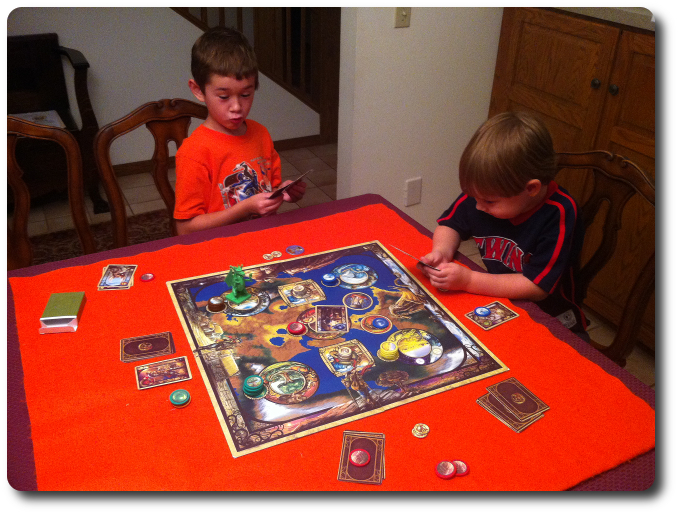
My little geeks loved playing the game and the artwork, but mostly, they loved taking points away from their dad
Gamer Geeks, your love of this game is going to be determined by your preferences in game types. Dragon’s Bard is a casual and light card game that can also be played as shrewdly as a Poker game for money. If you are the type of gamer who enjoys battling it out with cards and winning points because of smart card management, then this is a game for you. If not, we think you’ll still enjoy it, but will not be overly in love with it. Again, it comes down to you level of geekiness and your personal taste in games. Based on the positive reception from our Gamer Geeks, however, we have no problem suggesting this title to the game elitists.
Parent Geeks, here is a beautiful card game that will have your family and friends eager to play before you even have the game set up. The epic presentation of the game might have some non-gamers back peddling from the table thinking this is a game that requires a great deal of gamer knowledge and experience. But this is simply not the case. Dragon’s Bard uses tried and true game mechanisms that should be familiar to any person who has played traditional and classic card games. Even if you encounter someone who has not, the rules and game play are not complicated or demanding. Perhaps the real strength of the game is its ability to be played by a wide age and ability range. For those who know their way around a card game, Dragon’s Bard can become very cutthroat, but there is also more than enough room for casual game play.
Child Geeks, Dragon’s Bard is an easy game to learn how to play but not an easy game to win. You’ll need to think about your play and consider your choice in cards wisely. Sometimes the choices will be made for you as you must follow the rules of card play. But even then, you still have a choice. If you can’t win the Story token, take advantage of the lower cards to win Mandolins and Rumor tokens. These will count as points at the end of the game and help you towards victory!
Dragon’s Bard is beautiful to look at and easy to play, but it’s not doing anything new. Despite not winning any points for originality, the game is exceptional and was loved by all who played it. I predict great things for this game as it will attract both gamers and non-gamers alike to the same gaming table to share in a common experience. The ease of play makes it accessible to new players with little gaming background and for those who are familiar with hand and resource management, the game provides for strategy and tactics common in Hearts, Spades, and other trump card games. Combine that with a beautiful board and a clean design that provides for fast game play, and you’ve got yourself a winner.
It’s hard not to like a game that is enjoyed by so many and continues to surprise and entertain after countless game plays. I’ve been able to bring together at the gaming table groups I wouldn’t think possible and it’s an absolute joy to see non-gamers compete and even win against the Gamer Geeks. Humbling, surprising, and terribly entertaining.
Do take note of Dragon’s Bard. It is a game you will be able to play for years and years to come.
This game was given to Father Geek as a review copy. Father Geek was not paid, bribed, wined, dined, or threatened in vain hopes of influencing this review. Such is the statuesque and legendary integrity of Father Geek.




Hmm… too bad.
Turns out the current Dragon’s Bard Kickstarter campaign has been temporarily suspended. A note added to a Board Game Geek forum from the CEO of Albino Dragon, Mr. Erik Dahlman, states the reason why…
In the end, this was a very difficult decision but we feel that the final product will be the best game that we can possibly make.”
Full forum thread can be read here.
Please Note: This game has changed its name from Dragon’s Bard to Dragon Whisperer. The art has changed a bit, but the game play appears to be more or less the same. The game is available on Kickstarter until March 7th, 2013.